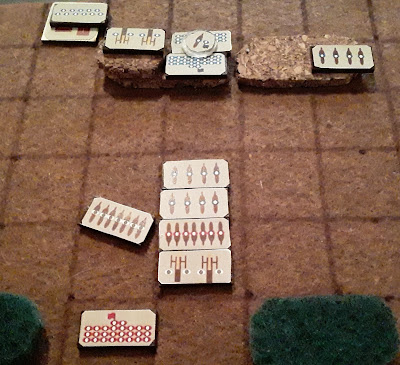From the Tales of Ser Killian
"Spoiler Alert"
Once again I used the D&D adventure Dragon of Icespire Peak. However, I turned this quest into a fast play RPG session so it bears only a passing resemblance to the original.
The Quest
After their success at Gromengarde, our party returns to Phandalin. Ser Killian manages to find a cleric to heal Winston. Then they take on the next challenge - find out what has happened at Butterskull Ranch.
What They Find at the Ranch
The ranch has been overrun by a band of orcs.
The party enters the ranch house and begins clearing out the marauders.
- In the first room, they run into 4 orcs. Ser Killian charges and wipes out half of them. His comrades take out the rest.
- Next, they encounter a lone orc. It calls for help but Gruff slays it. Then 3 more orcs arrive. The party wipes them out.
- They run into another 4 orcs but these also fall to the heroes' blades.
The Cellar
The party finds no more orcs in the upper levels of the house. Then they enter the cellar. Here they find a large, muscular orc torturing a bound human.
The heroes attack, but the orc warlord grabs a giant cleaver and begins swinging it wildly. The party has its hands full dodging the orcs attacks. Yet they manage to get in some attacks of their own. Soon the orc bleeds profusely.
But the orc is not done. It bellows in defiance and goes berserk. First, it slashes Brother Winston, who collapses in a pool of blood. Then Haiden and Gruff in turn taste the bite of the cleaver. Both are severely wounded.
Killian then makes an attack that stuns the orc. Haiden follows up and thrusts his spear deep into the orc's vitals. The orc crashes to the ground.
Aftermath
Killian manages to revive Winston. They also untie and tend to the orc's victim. He is the owner of the ranch. The orcs took him captive and had been tormenting him. He thanks the party for his rescue.
The party stays at the ranch, helping the owner, until Winston is well enough to travel. Then they return to Phandalin.
GAME NOTES
Once again, the adventure is a bit lackluster. I just turned it into a series of encounters against orcs until the party killed a certain number. Then they met an orc warlord, which was an addition of my own.
For this adventure, I experimented with streamlined rules. I'll post about them at a later date.


















